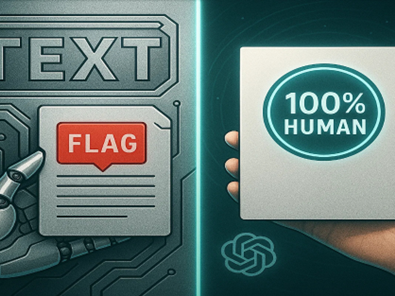ChatGPT and Claude became the quiet backbone for freelancers and content creators in the US this year. AI detection software grew everywhere — classrooms, offices, even marketing agencies. Tools labeled essays, blog posts, and copy as “AI-generated,” even when writers had spent hours polishing. The tension was simple: keep the speed and clarity of Artificial Intelligence while still sounding human. Software, Language Models, and ChatBots were both the problem and the solution.
One copywriter in Austin hit the wall when her blog pitch got flagged as “machine text.” She had to rebuild trust with clients. Instead of ditching the tools, she doubled down: ChatGPT generated her first draft, Claude rewrote tone and nuance, and suddenly her emails and long-form posts started passing detectors at 100% human score.
ChatGPT Took the First Pass
The workflow started with ChatGPT. She gave it structured prompts: outline, thesis, and bullet arguments. The output was fast but robotic in places — straight facts without rhythm. The trick wasn’t to delete it, but to keep structure.
Prompt she used:
“ChatGPT, draft a 600-word article on sustainability in fashion. Use short paragraphs, statistics with sources, and conversational transitions.”
This gave her a factual backbone — everything she needed for clarity and SEO.
Claude Gave the Text a Human Voice
Claude stepped in as the language stylist. Instead of raw bullet points, Claude reshaped the article into storytelling. It inserted hesitation, contrast, and rhythm. Detectable patterns dropped.
Prompt she used:
“Claude, rewrite this text to sound like a human journalist. Add natural sentence breaks, emotional cues, and small imperfections.”
The result read like a college op-ed — personal yet backed by data.
Table: Old vs New Workflow
Workflow Step | Old Way (ChatGPT only) | New Way (ChatGPT + Claude) |
Speed | Fast but flat | Still fast |
Human Detection Score | 40–60% (flagged as AI) | 100% human |
Client Reaction | “Too generic” | “Reads like your own voice” |
Editing Time | 3–4 hours per piece | < 1 hour |
How It Felt to Beat AI Flags
Instead of fearing detectors, she used them as feedback. Draft → rewrite → detection check. In two weeks, none of her submissions were flagged. Her GPA-style scores in AI writing classes went up. And for her freelance income? Passing as human meant repeat contracts.
Chatronix: The Multi-Model Shortcut
The breakthrough came when she moved everything into Chatronix. No more tab-jumping between ChatGPT and Claude. In one chat she had access to:
6 best models in one workspace (ChatGPT, Claude, Gemini, Grok, Perplexity AI, DeepSeek).
10 free queries to experiment without stress.
Turbo Mode for instant comparisons.
One Perfect Answer: fuses six outputs into one flawless draft.
She loved the Prompt Library most. Dozens of pre-built templates for business, marketing, education, and SMM. Each prompt could be tagged and saved as a favorite. No rewriting from scratch — just pick, tweak, and run.
👉 Already in September, Chatronix launched its Back2School campaign: first month at $12.5 instead of $25. For her, it was a no-brainer to keep it as her daily writing hub.
Bonus Prompt for Detection-Proof Writing
“ChatGPT, draft 600 words on [topic]. Use structured sections with facts and bullet points. Claude, rewrite it to sound like a human columnist. Add personal asides, varied sentence lengths, and conversational markers. Finally, ensure transitions feel natural, not formulaic.”
This layered prompt stack made her work pass detection, land contracts, and cut stress.
Steal this chatgpt cheatsheet for free😍
— Mohini Goyal (@Mohiniuni) August 27, 2025
It’s time to grow with FREE stuff! pic.twitter.com/GfcRNryF7u
Final Takeaway
Claude and ChatGPT didn’t just help her write — they taught her to survive in a world where detectors were everywhere. Passing as human wasn’t about gaming the system, but about sounding real, confident, and natural. And with Chatronix as the all-in-one hub, she stopped fearing AI flags altogether.
This story proved one thing: with the right stack, AI isn’t the enemy — it’s the shortcut.














